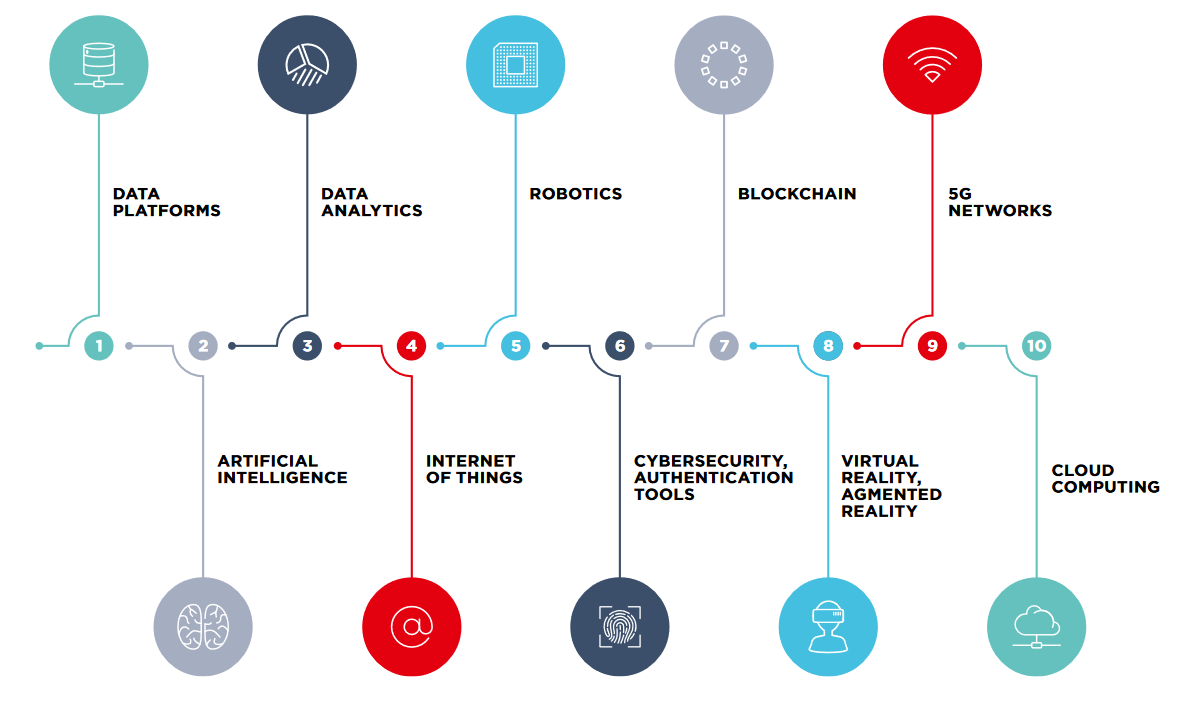포스트 코로나 시대의 10가지 핵심 기술
COVID-19 팬데믹은 우리의 생활, 일, 소비, 여행 방식을 변화시켰고 기업과 소비자의 기술 사용에 큰 영향을 미쳤다. 룩스이노베이션은 앞으로 향후 몇 달, 몇 년 동안 우리 경제에 중요한 역할을 할 10가지 핵심 기술인 데이터 플랫폼, AI, 데이터 분석, IoT, 로보틱스, 사이버보안과 인증도구, 블록체인, 가상현실 및 증강현실, 5세대 네트워크, 클라우드 컴퓨팅에 대해 “Post COVID-19 Market Trends” 리포트에서 소개했다.
In its report Post COVID-19 Market Trends, Luxinnovation’s market intelligence team identifies four major trends that will shape the economy: digitalisation, sustainability, resilience and new business strategies. The following 10 technologies are strongly linked to these market trends.

1. Data platforms
The pandemic has given a new impulse to the digital transformation of the economy, and data platforms are central tools. Data platforms – integrated technology solutions that allow data to be managed, accessed and delivered to users as well as data applications and other technologies – help organisations deliver fast, personalised and optimised solutions.
2. Artificial intelligence
The term artificial intelligence refers to technologies that enable computers and robots to perform intellectual processes normally conducted by humans: they can reason, discover meaning, generalise, learn from past experience, and so on. COVID-19 has speeded up the introduction of artificial intelligence across all industries. This is expected to continue after the pandemic, in particular in the areas of digitalisation, Industry 4.0, digital health and personalised medicine, and in building smarter supply chains.
3. Data analytics
Data analytics is crucial for deriving valuable information from data gathered from various sources: websites, sales, supply chains, etc. The terms is increasingly used to refer to statistical and mathematical analyses that cluster, segment and score data in order to derive intelligence used to predict what scenarios are most likely to happen. The adoption of data analytics is essential for the implementation of data-driven factories, the transformation of supply chains and the adoption of more agile and efficient business models.
4. Internet of Things
The Internet of Things is the common name for sensors and actuators embedded in physical objects – ranging from roadways to pacemakers – that are connected through wired and wireless networks. These objects produce huge amounts of data and drive digital business innovation in virtually all industries. The Internet of Things is closely linked to many of the technological developments that have been accelerated by the COVID-19 crisis, such as the increased digitalisation, the implementation of Industry 4.0, digital health and the development of smart supply chains.
5. Robotics
The impact of COVID-19 on the use of robotics was immediate: robot cleaners were used in hospitals, fast food chains relied robot cooks and servers, and e-commerce turned to robot deliveries. In the post-pandemic era, robotics will continue to accelerate digitalisation, modernise medical infrastructure, enable Industry 4.0 and stimulate the circular economy.
6. Cybersecurity and authentication tools
The outbreak of COVID-19 led to a drastic increase in the use of digital technologies as people turned to remote working, online shopping, virtual entertainment, and so on. This also resulted in a dramatic increase in cyber criminality. As a result, organisations will need to rethink their cyber risk management measures. Cybersecurity strategists will have to focus on implementing critical projects such as Zero Trust, software-defined security, Secure Access Service Edge (SASE) and identity and access management as well as automation to improve the security of remote users, devices and data.
7. Blockchain
During the pandemic, different solutions based on blockchain technologies have emerged to help deal with the global health crisis. Blockchain has boomed in the fields of tracking infectious disease outbreaks, donations tracking, crisis management and securing medical supply chains, for example.
8. Virtual and augmented reality
The general adoption of virtual and augmented reality has been somewhat slow the past few years, but the COVID-19 pandemic might well change this trend. In addition to its potential use for remote schooling and working, virtual reality and augmented reality are associated with several trends highlighted by the health crisis, including digital health and telemedicine, new entertainment patterns and virtual events and visits.
9. 5G networks
The response to COVID-19 has significantly affected the trends of remote work, home schooling and online shopping, as well as digital healthcare, manufacturing and mobility. 5G technology will be an essential enabler of this digital transformation.
10. Cloud computing
The pandemic has probably accelerated the shift to cloud computing for many companies. Cloud technology provides the agility and scalability that companies need to weather this and other crises effectively. Other factors such as cost reduction, reliability and the accessibility of data are also driving the market growth in this field.

